7.--Gold chloride...................... 1 gr. Acetate of soda.................... 30 gr. Water.............................. 2 oz.
The color of the prints toned by this bath is not exceedingly pleasing. It is a brown tending to purple, but is not very pure or bright. The results show, however, the possibility of toning the gelatino-chloro-citrate paper with the ordinary acetate bath if it be only made concentrated enough.
8.--Gold chloride...................... 1 gr. Carbonate of soda.................. 3 gr. Water.............................. 2 oz.
Very much the same may be said of the prints toned by this bath as of those toned by No. 7. The color is not very good, nor is the toning quite even. This last remark applies to No. 7 batch as well as No. 8.
9.--Gold chloride...................... 1 gr. Phosphate of soda.................. 20 gr. Water.............................. 2 oz.
The results of this bath can best be described as purplish in color. They are decidedly more pleasing than those of 7 or 8, but are not as good as the best by the sulphocyanide bath.
10.--Gold chloride..................... 1 gr. Hyposulphite of soda.............. 1/2 oz. Water............................. 2 oz.
The result of this bath is a brilliant brown color, what might indeed, perhaps, be best described as a red. Two out of the three prints are much too dark, indicating, perhaps, that this toning bath did not have any tendency to reduce the intensity of the image.
The general lesson taught by Clark’s experiments is that the sulphocyanide bath gives better results than any other. A certain proportion of the ingredients—namely, that of bath No. 3—gives better results than any other proportions tried, and about as good as any that could be hoped for. Any of the ordinary alkaline toning baths may be used, but they all give results inferior to those got by the sulphocyanide bath. The best of the ordinary baths is, however, the phosphate of soda.
And now a word as to those parts of the prints which have been treated with bichloride of mercury. The thing that strikes us as remarkable in connection with them is that in them the image has scarcely suffered any reduction of intensity at all. In most cases there has been a disagreeable change of color, but it is almost entirely confined to the whites and lighter tints, which are turned to a more or less dirty yellow. Even in the case of the prints toned by bath No. 10, where the image is quite red, it has suffered no appreciable reduction of intensity.
This would indicate that an unusually large proportion of the toned image consists of gold, and this idea is confirmed by the fact that to tone a sheet of gelatino-chloro-citrate paper requires several times as much gold as to tone a sheet of albumenized paper. Indeed, we believe that, with the emulsion paper, it is possible to replace the whole of the silver of the image with gold, thereby producing a permanent print. We have already said that the print may be left for any reasonable length of time in the toning bath without the destruction of its appearance, and we cannot but suppose that a very long immersion results in a complete substitution of gold for silver.




